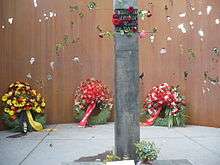Oktoberfest terror attack
| Oktoberfest Terror Attack | |
|---|---|
 Monument at the site | |
| Location | Munich, West Germany |
| Date | September 26, 1980 |
| Target | Oktoberfest participants |
Attack type | Bombing, mass murder, neo-Nazi terrorism |
| Weapons | Pipe bomb |
| Deaths | 13 (including the perpetrator) |
Non-fatal injuries | 211 |
| Perpetrator | Gundolf Köhler |
The Oktoberfest terror attack was a terrorist attack with a right-wing radical background. On 26 September 1980, 12 people died and 211 were injured after the explosion of an improvised explosive device at the main entrance of the Oktoberfest in Munich, West Germany. The attack is considered to be the most severe act of terrorism in post-war West Germany. The attack was attributed to the right-wing extremist and geology student Gundolf Köhler who was killed while placing the explosive device; however, doubts remain as to whether he acted alone. Repeated attempts to re-open the investigation in the years that followed the bombing have not been successful until 2014.
The attack and its immediate impact
Oktoberfest is an outdoor beer festival held during a 16-day period running from late September to the first weekend in October, celebrating beer in Munich, Germany.
At 10:19 p.m. on 26 September 1980, a bomb exploded at the main entrance to Oktoberfest, killing 12 people instantly and injuring 225 people. Amongst the individuals killed were one Briton, one Swiss, and three German children, aged 6, 8, and 10; the remaining victims were West German adults.[1]
The bomb had been planted in a litter bin at about waist level, allowing it to wreak significant havoc upon detonation. Approximately 50 of the 225 “non fatal” casualties experienced serious, life-threatening injuries with the potential to impact the afflicted individuals for the rest of their lives. The area affected by the bombing was the size of a soccer field, which measures at 100 yards long (the same size as a football field) and 60 yards wide. Such demonstrates the devastating impact of this bomb and underscores why it was able to impact a large number of people. Furthermore, analysis of the bomb provides insight into why it was able to be particularly devastating. Reconstruction from the site of the bombing indicates that it was created from a British mortar projectile manufactured in 1954. This particular projectile was modified to ensure an intense degree of fragmentation, which would assist in causing as many fatalities (and severe injuries) as quickly as possible.
Criticism of the official investigation
The "single attacker" theory that was the conclusion of the official investigation has been doubted by many, including local politicians, victims and various journalists and attorneys.
The criticisms of the official investigation include the fact that known connections between Köhler and the Wehrsportgruppe Hoffmann, a known neo-Nazi militia, were all but ignored in the final report. Also, several eyewitness accounts of the attack itself mentioned Köhler speaking to two individuals wearing olive parkas immediately prior to the explosion as well as statements that a second individual was seen with Köhler looking into the plastic bag that the IED was believed to be in.
The last remaining pieces of evidence from the attack such as shrapnel from the IED were disposed of in 1997. This is routine in investigations that are considered cleared, yet it created some blow-back due to the political background of the attack and the lingering questions surrounding the official investigation.
References
- ↑ Gerber, Larry (29 September 1980). "Neo-Nazi Group Suspected in Munich Oktoberfest Bombing". The Lewiston Daily Sun. Retrieved 21 November 2013.
External links
- Oktoberfest-Attentat, 26 September 1980 (German), Historisches Lexikon Bayerns (Bavarian historical lexicon).
Coordinates: 48°08′09″N 11°32′59″E / 48.13592°N 11.549736°E